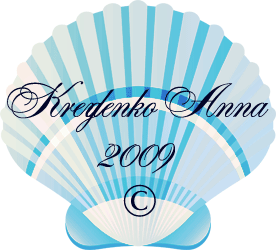European art
Seascape is a type of landscape, a special genre in painting, (or marine from lat. marinus through fr. marine, - maritime).
Marine art depicts sea views and also scenes of naval battles or other events connected with the sea.
The main difficulty in painting seascapes from life is that the state of the sea changes every moment,
but this changeability of the sea also gives opportunity for artists to improvise, using their imagination.
The main thing in seascapes is to draw sea in different states and the conflict between a man, got into
the gale, and sea element.
The first marine in the history of world art was the fresco entitled “Maritime port”,
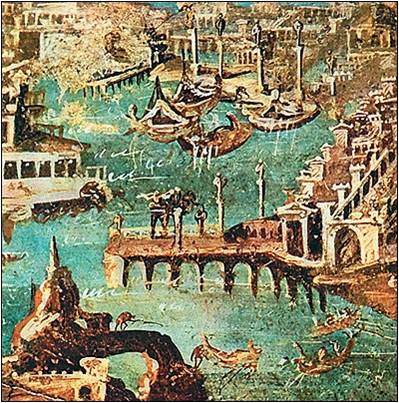 which was a real seascape. It was found by archeologists among other paintings in one of the patrician houses,
which was destroyed in 79 year during the
eruption of volcano Vesuvius.
which was a real seascape. It was found by archeologists among other paintings in one of the patrician houses,
which was destroyed in 79 year during the
eruption of volcano Vesuvius.
The marine genre originates from the art of Flemish artists. The main of them was Piter Bruedhel the Elder. However, marine as a genre painting appeared in Europe only at the end of
the XVI – first half of the XVII centuries.
Netherlands (Dutch) Bourgeois Revolution (1566-1609) enlivened Dutch cultural life and
favored the creative progress. The XVII century saw the flowering of Dutch School and all its genres,
particularly landscape. The Dutch artists depicted the surrounding world in all its richness in their
works. It was in Holland where the marine genre painting quickly became widespread. The seascape was
very popular in the Netherlands, the country of seafarers and fishermen. Among the best marine artists
were W. van de Velde,
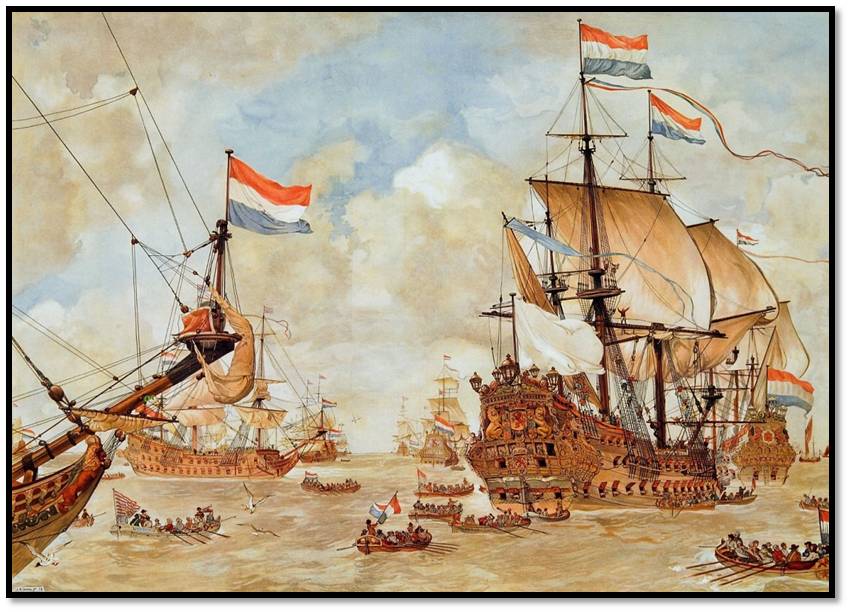 S. de Vlieger, J. Porcellis and J. van Ruysdael. Subdued colouring is typical for the majority of
Dutch landscapes. It is with tints of light silver, ochreous, brown, which are similar to original
nature colours. These colours, which have been laid on the canvas in subtle, accurate strokes,
convincingly and naturally reproduce the surrounding world.
S. de Vlieger, J. Porcellis and J. van Ruysdael. Subdued colouring is typical for the majority of
Dutch landscapes. It is with tints of light silver, ochreous, brown, which are similar to original
nature colours. These colours, which have been laid on the canvas in subtle, accurate strokes,
convincingly and naturally reproduce the surrounding world.
From the XVII century seascapes began to appear in pictures of French
artists: Nicolas Poussin, who was the founder of classicism, and Claude Lorrain. Poussin
interpreted nature as the world which is subordinate to the laws of mind. And in classicistic paintings
sea is “reasonable”. Marines, which he created in that style, are the works with balanced composition,
great built spatial plans (in the foreground - plain, in the middle ground – giant trees, in the background
- sea) and clear division of colours (system
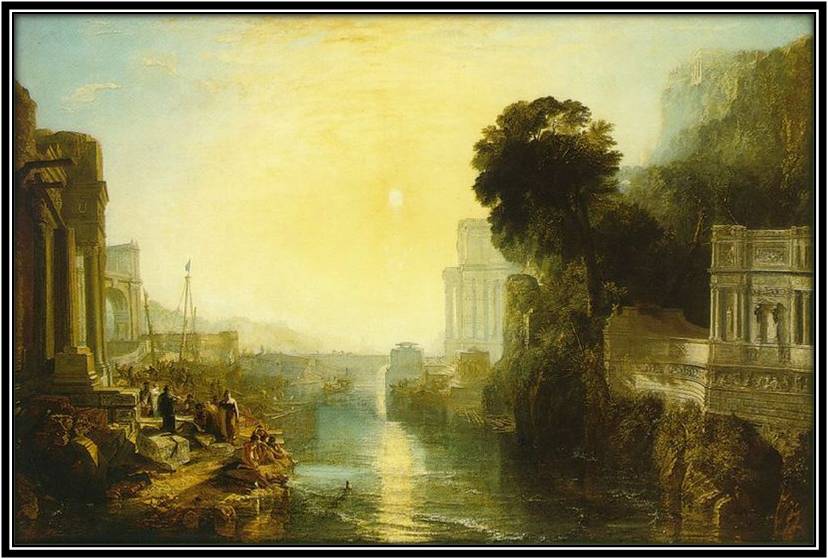 called later “landscape pansy”; the main principle of which is that yellow and brown colours dominate the
foreground, warm and green tones- the middle ground, cold and first of all blue - the background). As
a result, the imagery of an ideal world was created, the world made up according to the high mind’s laws.
The contemplators of his landscapes enjoyed the painting and perfected their mind.
called later “landscape pansy”; the main principle of which is that yellow and brown colours dominate the
foreground, warm and green tones- the middle ground, cold and first of all blue - the background). As
a result, the imagery of an ideal world was created, the world made up according to the high mind’s laws.
The contemplators of his landscapes enjoyed the painting and perfected their mind.
Claude Lorrain, the classicist artist, devised the conception of idyllic landscape.
His paintings are full of ideal harmony. The artist creates the plans so skillfully, that a lot of place
is left on the canvas for drawing wide spaces of sea, ground and atmosphere. Mythological creatures are
situated in the middle of Poussin’s pictures, but in Lorrain’s works they are only subsidiary elements.
Quite differently nature is represented in the pictures of the painters
who worked in baroque style. Unlike classicists they tried to show the dynamics of the surrounding
world. In the beginning of the XVIII century the Italian artist, Alessandro Magnasco, created
emotionally expressive landscapes, where baroque traditions were shown. There is nothing idyllic in his works.
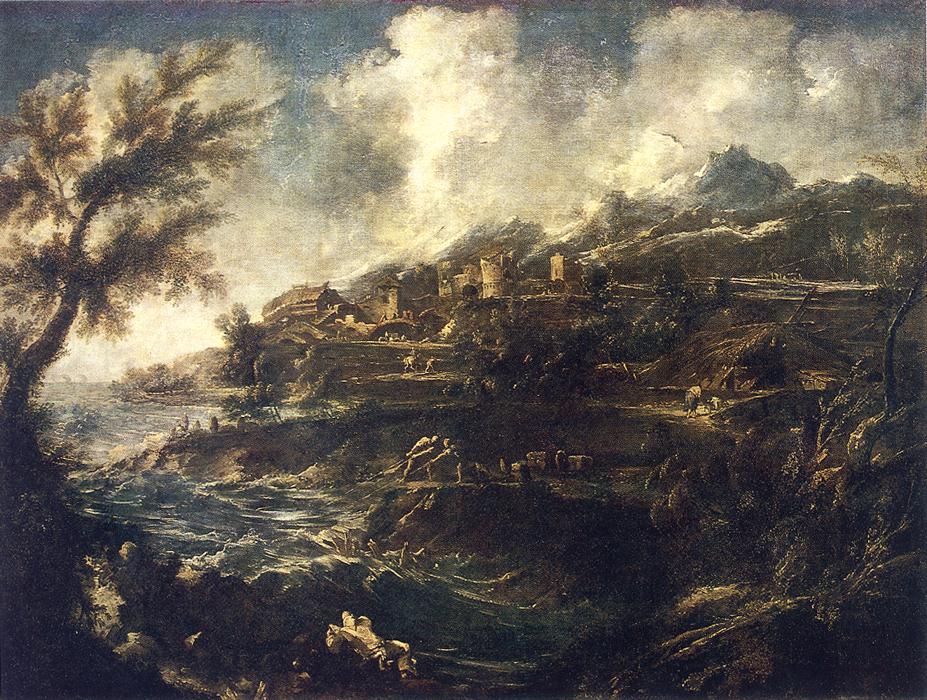 They are full of anxious feeling and draw the complexity of the Universe. In the picture “Seashore”
the audience can see the chaotic pile of details. Rough sea waves are crashing against the shore,
where the artist placed a lot of human figures. These figures are robbers, gypsies peasants, hermits,
merchants. It is difficult to understand what they are doing. And the landscape is mysterious and romantic
too: there is the choppy sea, trees with curved trunks, dark fortresses with towers and high grey mountains
on the horizon.
They are full of anxious feeling and draw the complexity of the Universe. In the picture “Seashore”
the audience can see the chaotic pile of details. Rough sea waves are crashing against the shore,
where the artist placed a lot of human figures. These figures are robbers, gypsies peasants, hermits,
merchants. It is difficult to understand what they are doing. And the landscape is mysterious and romantic
too: there is the choppy sea, trees with curved trunks, dark fortresses with towers and high grey mountains
on the horizon.
There was a development of landscape painting in French art in the XVIII century.
A brilliant French artist of rococo movement was Francois Boucher. He created landscapes full of emotional
fascination. They are like magic wonderful dreams made up of blue, pink, and silver tints (“Landscape Near
Beauvais”). Boucher was the teacher of another French artist Jean-Honore Fragonard, who painted in the style
of rococo. Fragonard’s colourful landscapes, which are full of air and light, show the freshness of the air,
the heat of sun’s rays, trembling movement of trees’ leaves (“Gardens of the Ville d’Este”, London). His
landscapes, created in delicate colours, depict different tints of the mood.
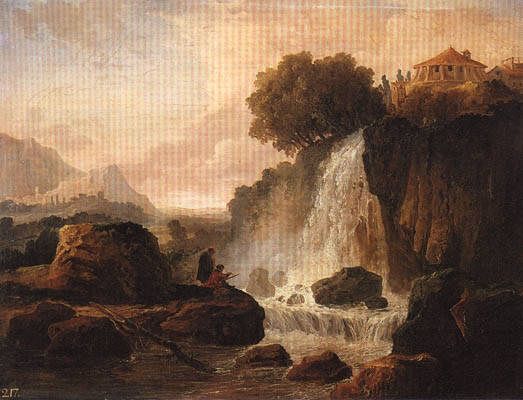 A new attitude to nature in art was formed in the second half of the XVIII century.
Nothing from that former idyllic conditionality that was common for rococo remains in landscape genre
painting during the Age of Enlightenment.
The artists tried to show the audience real nature, which is raised to the esthetic ideal. Most of the
artists, who worked in that period, turned to the antiquity, in which they saw the prototype of the
personality’s freedom. Hubert Robert’s works can be an example of that. Robert like other artists of
that time combined reality and fiction in his compositions.
A new attitude to nature in art was formed in the second half of the XVIII century.
Nothing from that former idyllic conditionality that was common for rococo remains in landscape genre
painting during the Age of Enlightenment.
The artists tried to show the audience real nature, which is raised to the esthetic ideal. Most of the
artists, who worked in that period, turned to the antiquity, in which they saw the prototype of the
personality’s freedom. Hubert Robert’s works can be an example of that. Robert like other artists of
that time combined reality and fiction in his compositions.
The period from the end of the XVIII to the beginning of the XIX century is
the time of romantic genre painting of seascapes. The painting of gales and seaports by Frenchman
Claude Joseph Vernet
 were based on natural observation of the artist. His works with their bright light effects were greatly
admired by his contemporaries. Vernet’s painting technique influenced the members of Romantic Movement,
which appeared in European and American art in the first half of the XIX century. Among the greatest
romanticists in England were Joseph Mallord William Turner (his last works were painted in light,
transparent quickly strokes; Turner preferred light colours, whitewash and different tints of yellow
and brown, he never used green and black colours) and John Constable, in Germany – Caspar David Friedrich.
were based on natural observation of the artist. His works with their bright light effects were greatly
admired by his contemporaries. Vernet’s painting technique influenced the members of Romantic Movement,
which appeared in European and American art in the first half of the XIX century. Among the greatest
romanticists in England were Joseph Mallord William Turner (his last works were painted in light,
transparent quickly strokes; Turner preferred light colours, whitewash and different tints of yellow
and brown, he never used green and black colours) and John Constable, in Germany – Caspar David Friedrich.
Barbizon School (France) played one of the leading roles in the development of marine genre.
It appeared in 1830s – 1860s.
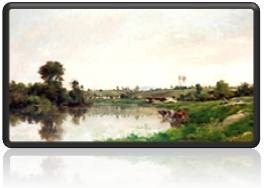 The artists of this School tried to depict nature without dramatic effects, as they supposed that
strict, conservative and far from life academic methods prevented the development of the individual
and were unacceptable. These artists greatly influenced the development of realistic art in France.
Their landscapes taught the public to perceive vivid impressions from nature. From that time landscape
genre stopped to be minor and insignificant.
The artists of this School tried to depict nature without dramatic effects, as they supposed that
strict, conservative and far from life academic methods prevented the development of the individual
and were unacceptable. These artists greatly influenced the development of realistic art in France.
Their landscapes taught the public to perceive vivid impressions from nature. From that time landscape
genre stopped to be minor and insignificant.
The French artists such as Claude Monet, Camille Pissarro, and Alfred Sisley
depicted the beauty of rural nature in their pictures. Their landscapes painted in the open
air show the deep interests of the artists in the changeable sky and light.
 Impressionism is an art style, which appeared at the end of the XIX century. The term “Impressionism”
originated from the name of Claude Monet’s painting “Impression: sunrise” (1872), which was exhibited
at the first Impressionist exhibition in 1874.
Impressionism is an art style, which appeared at the end of the XIX century. The term “Impressionism”
originated from the name of Claude Monet’s painting “Impression: sunrise” (1872), which was exhibited
at the first Impressionist exhibition in 1874.
The main rule of impressionists was the work in open air (“en plein air”).
There were no contours on impressionistic pictures. The artists believed that it was possible
to depict only the instant impression produced by the colour and the form of the object and solving
this problem they discovered a new method of painting. They never used mixed colours, only pure vivid
tints and rich separate strokes.
Post-impressionists used some impressionists’ methods in their art.
Paul Cezanne depicted nature in all its richness and greatness. Vincent van Gogh’s
landscapes are full of dark, tragic feeling.
 Neoimpressionists created their pictures in technique called pointillism. Georges-Pierre Seurat
and Paul Signac are the most famous to paint in this style. Their works show sunlight’s patches
on the surface of water, maritime air and freshness of leaves. Pure colours are put in separate
small strokes, which are similar to points.
Neoimpressionists created their pictures in technique called pointillism. Georges-Pierre Seurat
and Paul Signac are the most famous to paint in this style. Their works show sunlight’s patches
on the surface of water, maritime air and freshness of leaves. Pure colours are put in separate
small strokes, which are similar to points.
In the XX century a lot of artists painted landscapes. The landscapes of the
Fauves were characterised by seemingly wild brush work and strident colours. The leaders of this
movement were Henri Matisse, Andre Derain, Albert Marquet, Charles Camoin, Louis Valtat and etc.
In the XX century great masters of landscape genre were realistic artists:
Rockwell Kent, Renato Guttuso and etc.

